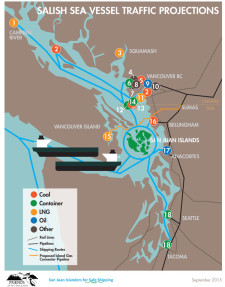Marine Vessel Traffic Projections
Posted September 25, 2015 at 5:45 am by Tim Dustrude

Click image to enlarge graphic or click here to download the full 13 page report (PDF)
Salish Sea Vessel Traffic Projections: A 43 Percent Increase
If all the new and expanding terminal and refinery projects in the Salish Sea are permitted and developed, including projects that became operational in 2014, there would be a 43 percent increase in large, commercial marine vessel traffic.
FRIENDS of the San Juans and San Juan Islanders for Safe Shipping have released the Salish Sea Vessel Traffic Projections featuring 18 new or expanded proposed or recently completed projects, which cumulatively would add an additional 5,300 annual vessel transits to and from ports in British Columbia and Washington State.
The Salish Sea includes the international Strait of Juan de Fuca, Haro Strait, Boundary Pass and southern Georgia Strait; Washington State’s Puget Sound and San Juan Islands; and British Columbia’s Gulf Islands and Strait of Georgia. The Salish Sea also includes critical habitat for species listed as endangered in both Canada and the US including the Southern Resident Killer Whale, Chinook salmon, rockfish and marbled murrelet.
FRIENDS of the San Juans partnered with San Juan Islanders for Safe Shipping to research and create the Salish Sea Vessel Traffic Projections flyer given the lack of current consolidated vessel traffic projections for British Columbia and Washington State.
“These projects all have one thing in common – they all transit through the San Juan Islands.” said Stephanie Buffum, Executive Director of FRIENDS of the San Juans.
“From ocean-going container ships, bulk cargo carriers, oil tankers, liquefied natural gas carriers, and underwater pipelines, our inland sea could have a 43 percent increase in vessel traffic. Neither Canada nor Washington is looking at the potential impacts of this cumulative increase. Maintaining clean water is critical to our environment and our economy.”
In 2013 there were 12,394 large, commercial vessel transits in the Salish Sea. These vessel transits don’t include the many fishing and pleasure boats that share these waterways with the vessel traffic generated from existing terminals and refineries. In Canada, Port Metro Vancouver is that country’s largest port, the third largest port in North America, and home to 27 major marine cargo terminals. In the United States, Washington State has five refineries and major ports in Seattle, Tacoma, Everett, and Port Angeles. Most of the increased vessel traffic would come from British Columbia (BC), Canada, including four proposed LNG export facilities. The Malahat LNG proposal, south of Mill Bay, BC, also includes the proposed Island Gas Connector pipeline project, which would transport natural gas from Sumas, Washington, over land to Cherry Point, and then underwater through Whatcom and San Juan counties and into BC.
Container ship traffic is projected to increase by a total of 1,300 transits per year. There are two new container terminal proposals and one container terminal expansion underway in Port Metro Vancouver. The ports of Seattle and Tacoma recently formed the Northwest Seaport Alliance with plans to increase their container terminals’ capacity from 3,400,000 TEUs (Twenty-foot Equivalent Units) to 6,000,000 TEUs per year.
The project that represents the greatest oil spill risk is Kinder Morgan’s proposed Trans Mountain Pipeline Expansion project, which would increase Canadian oil sands crude oil exports from 300,000 to 890,000 barrels per day. This project’s oil spill risk is compounded by the amount of increased vessel traffic and the volume and type of crude oil cargo, which is more environmentally damaging and more costly to clean up in the event of a spill. Project-related tanker vessel traffic would increase from 120 transits per year to 816 oil tanker transits per year.
The San Juan County Council’s comment letter to Canada’s National Energy Board (NEB) regarding the Trans Mountain Pipeline Expansion project states, “We feel this project will benefit few while posing undo risk for those along its route. Our biggest concerns are increased vessel traffic in our waters that increase the risk of an oil spill from collision or running aground. The NEB is looking at this one individual project and its impacts. San Juan County feels this is shortsighted and inadequate. This project does not exist in a vacuum. We urge the NEB with other ministries and US counterparts to examine all proposed marine terminal projects and examine cumulative impacts of increased vessel traffic.”
“We applaud the San Juan County Council for their advocacy on this issue,” said Shaun Hubbard, Co-founder of San Juan Islanders for Safe Shipping. “We hope that the information consolidated in the Salish Sea Vessel Traffic Projections flyer will educate the public and decision-makers, and advocate for the cumulative impacts analyses needed for all the new and expanding terminal and refinery proposals.”
The Salish Sea Vessel Traffic Projections flyer and source information are available at http://www.sanjuans.org/safeshipping/.
You can support the San Juan Update by doing business with our loyal advertisers, and by making a one-time contribution or a recurring donation.
Categories: Around Here










No comments yet. Be the first!
By submitting a comment you grant the San Juan Update a perpetual license to reproduce your words and name/web site in attribution. Inappropriate, irrelevant and contentious comments may not be published at an admin's discretion. Your email is used for verification purposes only, it will never be shared.